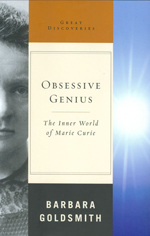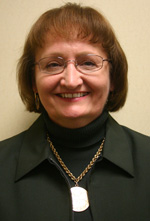Review of "Obsessive Genius: The Inner World of Marie Curie"

Author(s): Barbara Goldsmith
Published: November 2004, W.W. Norton & Company, ISBN: 0393051374
 by Carol H. Weaver, Ph.D., Associate Professor of Biology
by Carol H. Weaver, Ph.D., Associate Professor of Biology
June 155, 2005 -
Ten years ago the chairman of my Ph.D. committee, a woman, presented me with a brand new biography, Marie Curie A Life by Susan Quinn. She inscribed on the flyleaf, in part, this thought: “A book about a unique struggle by a scientifically curious mind.” It is telling that my mentor never used the word “woman” anywhere on this page; she herself was a person of science merely passing along to me a book about another scientist who was to be respected and admired for great achievements.
At that time, ten years ago, women were not oddities in science nor had they been for some time. Most of my classes in graduate school had as many if not more women students than men. That trend continues in my own classrooms now and it is never surprising to find my class rolls listing more female than male names. Harvard President Lawrence H. Summers’ recent comments notwithstanding, women have found their places in science and mathematics and are encouraged to develop their potentials with less and less prejudice against them because of the fact that they are female. Such has not always been the case.
It was revealing to read the biography of Marie Curie my mentor gave me; Madame Curie did indeed have many struggles related to the bias of the day against women scientists, but her shining intellect and drive propelled her well beyond the barriers a male-dominated society wished to maintain. This message is the theme of a new biography Obsessive Genius/The Inner World of Marie Curie by Barbara Goldsmith. Goldsmith, who had access to many previously sealed papers belonging to Marie Curie, was able to probe into the apparent thought processes that lead this person of science through the struggles of life to scientific immortality. She emphasized the fact that Marie Curie was a real woman, one with whom today’s women in science can relate. The myth of Marie Curie is strong and riveting, but the story of the woman behind the myth as told by Goldsmith is equally compelling.
Marie Curie, the French name assumed by the Polish woman born Marya Salomee Sklodowski in 1867, was indeed as “rare as a unicorn in science.” In a day of carefully controlled social expectations, Marie’s parents reared her and her siblings to be thinkers and doers with little consideration of what society thought. Marie’s talents in academia appeared early and never ebbed and she was particularly skilled in mathematics. Marie received a gold medal for the best pupil of 1883 at the government school she attended. That she was first in her class was fundamental to her drive even at a young age. She became the first woman to earn a physics degree at the Sorbonne, in 1893, and a year later to add a second degree, in mathematics, to her growing list of achievements.
Though obsessively driven to do her best, the journey to fame was fraught with extreme prejudice against her both as a female and as a person brought up in relative poverty. When she fell in love, it was with passion and fire. However, the young man’s parents did not consider her to be the social equal of their son and pressured him to distance himself from Marie. This was the start of a series of failures and achievements, depressions and joys that were to mark her entire life. Faced with this setback in her love life, she decided to pursue her academic career with single-mindedness, never giving another thought to love and marriage. This decision allowed her to seek education at all costs, even to living in the freezing garret rooms in Paris that have become so much a part of her legend. She seemed not to mind the double standard of the times when the “rare female scientist was depicted as masculine, coarse, ugly, careworn and industrious but making no significant contribution.” It was characteristic of Marie Curie to give no credence to prevailing thoughts of the day but rather to push on to the tune of her own inner task master.
Her bleak outlook on romance was, in typical Curie fashion, overturned by an unexpected friendship she made at the Sorbonne. Marie had a failed romance in her past and was not looking for another chance at love, and her new friend Pierre Curie was convinced he could only be happy with a “woman of genius” and was not expecting to find one. Neither was searching for love, but as they shared their scientific dreams, love found them. They married and their honeymoon was a wedding “tramp” on bicycles for an entire summer during which they had the opportunity to truly fall deeply in love. On their return, the pair began collaborating in their work. She worked on measuring and quantifying the magnetism of various steel products and he made her work easier by providing instrumentation and calibrating those instruments. This early sharing of work continued to be conspicuous throughout their careers, with each contributing his or her own areas of expertise to a common problem. Frederick Soddy summarized it very well: “Marie Curie’s greatest discovery was. . . radioactivity. Pierre Curie’s greatest discovery was Marie.”
Unfairly, but not out of character for scientists of the day, fellow scientists gave her achievements short shrift. Even on becoming the first woman to win a Nobel Prize (in physics for the discovery of radioactivity, a prize shared with Pierre Curie and Henri Becquerel), she was deemed an assistant to her husband. The stipend was split 50-50 between Becquerel and the Curies as though Marie had not earned her third. It was Pierre himself at the Nobel award ceremony who gave her her just due in the speech he presented; Marie was not permitted to speak. Later, Marie Curie was presented a second Nobel Prize as a single winner. This prize, in chemistry for the isolation of polonium and radium, was a recognition that should have shown the scientific world that she was a researcher of note who should not be relegated solely to the category of “woman.” However, Madame Curie was forced throughout her career to campaign for funds for research; men in the same position were readily granted laboratory space and funding. No amount of bias kept her from her work, though, and she racked up a series of other “firsts” including becoming the first woman to be elected to the French Academy of Medicine and the first woman to be buried in the Pantheon in Paris.
Barbara Goldsmith points out throughout her biographical account of Marie Curie that Marie had the same domestic problems of any woman with a demanding career. She had to manage a home with cooking and cleaning, deal with domestic finances, care for a baby, and cope with the fatigue that comes with attempting to excel at both career and home. Shortly after her first child was born, Marie’s physician father-in-law came to her rescue domestically when he moved in with Marie and Pierre to take care of the child and the home. This freed Marie to pursue her research to the point of often ignoring her child. This child, Irene, so craved attention that she made herself into a replica of her mother, even to the winning of the third Nobel Prize to be given a woman scientist. Shortly after a second daughter was born, Pierre died in an accident, which some suggest was attributable to inattention brought on by radium poisoning. Marie, herself in poor health during much of her career due to exposure to radioactivity, was then in the unenviable position of being a single mother raising two young children.
Obsessive Genius provides the salient details of Marie Curie’s life, but more importantly and thus giving a reason for another Curie biography, it delves into the everyday issues of this working mother and wife, examining the underlying forces that shaped Marie as a woman of genius. A great difference between Marie and for her current-day sisters is that she also faced and overrode overwhelming prejudice against females in a male-dominated career to become considered a person of mythic proportions. Unquestionably, Marie Curie not only set the standard for any person of science but she also broke the ground for women especially to follow in research. Exactly how much credit Marie Curie deserves, being the first woman to excel in so many science areas, for making it possible for other women to “do science” certainly is up for debate. However, one would have to work hard to make a case that such credit should not be great. Those of us women scientists who have followed Marie Curie should always be grateful for her influence and the fact that not only did she make an impression, she made a monumental one; it is common today to hear that it is a woman who has made a lasting discovery. Indeed, if today we are hearing of fewer distinctions being made on the basis of gender of scientists, then we should acknowledge the colossal contribution made in this arena by Marie Curie.

